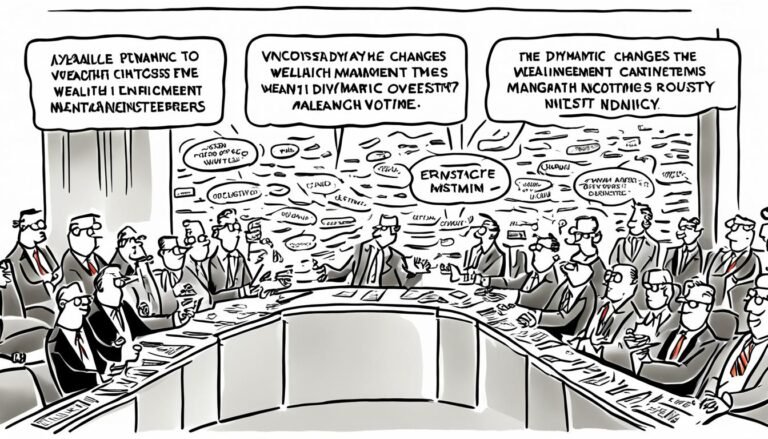Wealth Management Case Studies: Outcomes Unveiled
Did you know that analyzing wealth management case studies can provide valuable insights into successful strategies and failures in managing wealth? These real-life examples offer a glimpse into the world of financial case studies, investment success stories, and wealth management lessons learned. By studying these cases, individuals can gain knowledge and understanding of best practices in portfolio management and wealth management.
Key Takeaways:
- Wealth management case studies offer real-life examples of successful strategies and failures in managing wealth.
- Studying these case studies can provide valuable insights and lessons learned in portfolio management and wealth management.
- Case studies highlight the importance of long-term planning, diversification, and personalized financial advice.
- By applying the lessons from these case studies, individuals can improve their financial decision-making and increase their chances of achieving their wealth management goals.
- Success stories in wealth management showcase effective portfolio management and long-term investment strategies.
The Impact of Conscientiousness on Financial Decision-making
Conscientiousness, a personality trait characterized by being hardworking and responsible, has a significant impact on financial decision-making and overall financial well-being. Studies have shown that individuals who possess conscientiousness tend to exhibit better financial habits, leading to long-term financial stability. Moreover, **conscientious** individuals are more likely to plan for the future, make sound financial choices, and achieve better **health outcomes**.
Research has consistently demonstrated a positive correlation between conscientiousness and financial well-being. It indicates that individuals with a high level of conscientiousness are more likely to engage in **prudent financial behaviors**, such as budgeting, saving, and investing wisely. They prioritize responsible money management and minimize impulsive or risky financial decisions, thus safeguarding their financial futures.
“Conscientiousness is a powerful predictor of financial success. It influences financial behaviors and attitudes, ultimately shaping financial outcomes.”
Personality Traits and Financial Habits
Studies have explored the intricate relationship between personality traits and financial habits, consistently highlighting the impact of conscientiousness. **Conscientious** individuals typically exhibit characteristics such as discipline, organization, perseverance, and self-control, which naturally translate into positive financial behaviors.
These individuals are more likely to establish and adhere to budgets, prioritize saving for the future, and engage in long-term financial planning. They are less inclined to succumb to immediate gratification and impulsive purchases, instead focusing on their financial goals and making choices aligned with their objectives.
Furthermore, **conscientiousness** extends beyond financial decision-making. Its influence permeates various aspects of an individual’s life, including career success, relationships, and overall well-being. By exhibiting conscientiousness in financial matters, individuals foster a sense of control over their financial futures and set themselves up for improved financial outcomes.
Financial Habits and Long-term Financial Stability
**Financial habits** cultivated by individuals with conscientiousness play a crucial role in achieving long-term financial stability. The consistent practice of responsible financial behaviors, such as saving regularly, investing wisely, and managing debt effectively, contributes to overall financial well-being.
By building a strong foundation of financial habits grounded in conscientiousness, individuals can withstand financial challenges and better manage unexpected expenses. Additionally, they are more likely to accumulate wealth over time, ensuring they have the resources to meet their financial goals and aspirations.
In Summary
Conscientiousness plays a crucial role in shaping financial decision-making and overall financial well-being. Individuals who exhibit conscientiousness tend to adopt better financial habits, plan for the future, and make sound financial choices. By prioritizing responsible money management and long-term financial planning, these individuals secure their financial well-being and increase the likelihood of achieving their financial goals.
Case Study: The Financial Prudence of Conscientiousness
In a comparative financial case study, we analyzed the decisions of two individuals with different levels of conscientiousness. The case study shed light on how a conscientious approach, characterized by retirement planning and long-term growth, can lead to better financial outcomes.
Individuals who prioritize immediate gratification and lack future planning often face a significant retirement income gap. However, those who adopt a conscientious mindset can bridge this gap and achieve financial security in their later years.
The Role of Conscientiousness in Retirement Planning
Conscientiousness plays a crucial role in retirement planning. Individuals who possess this trait tend to value long-term financial stability over immediate gratification. They understand the importance of saving, investing, and creating a diversified portfolio to ensure a comfortable retirement.
A conscientious individual is more likely to set specific financial goals, create a budget, and stick to it. They consistently contribute to retirement accounts and carefully monitor their expenses. This disciplined approach sets them on the path to financial success.
Conscious individuals also exhibit a higher degree of financial literacy. They seek knowledge and information about various investment vehicles, understand the risks involved, and make informed decisions to maximize long-term growth.
A Tale of Two Approaches
To illustrate the impact of conscientiousness on financial outcomes, let’s examine the case study of two individuals: John and Sarah.
| John – Low Conscientiousness | Sarah – High Conscientiousness | |
|---|---|---|
| Retirement Planning | Did not prioritize retirement planning, saved sporadically, and relied on short-term investments. | Started planning early and consistently contributed to retirement accounts. Employed a long-term growth strategy. |
| Portfolio Diversification | Invested in individual stocks without thorough research. No diversification. | Utilized a diversified portfolio comprising stocks, bonds, and mutual funds. |
| Financial Habits | Impulsive spender, prone to immediate gratification, and rarely monitored expenses. | Maintained a budget, tracked expenses, and made conscious choices to save and invest. |
| Retirement Income Gap | Faced a significant retirement income gap due to lack of planning and growth. | Enjoyed a comfortable retirement with a steady income stream and financial security. |
The case study clearly demonstrates how a conscientious approach to retirement planning leads to long-term success. Sarah’s conscientious approach, encompassing responsible financial habits and long-term growth strategies, allowed her to bridge the retirement income gap. Meanwhile, John’s lack of conscientiousness left him facing financial challenges in retirement.
By examining this case study, we can learn a valuable lesson: conscientiousness is a key characteristic for achieving financial security in retirement. It’s never too late to adopt conscientious financial habits and start planning for the future.
Success Story: Wealth Management for Early Retirement
A case study of a couple in their mid-40s highlighted the successful planning and management of wealth for early retirement. With the guidance of a wealth management firm, the couple was able to develop a diversified portfolio tailored to their risk tolerance and time horizon. They also implemented tax-saving strategies, coordinated their estate plan, and set up structured education funding for their children, ultimately achieving their goal of early retirement.
John and Mary Smith, a couple in their mid-40s, had always dreamt of retiring early and enjoying a life of financial independence. However, they were uncertain about how to navigate the complex world of wealth management and retirement planning. That’s when they decided to seek the expertise of Wealth Advisors Inc., a reputable wealth management firm known for its expertise in early retirement planning.
Under the guidance of their dedicated financial advisor, the Smiths began by discussing their long-term goals and aspirations. They expressed their desire to retire by the age of 55 and maintain a comfortable lifestyle without worrying about their financial security. With this information, the advisor created a personalized wealth management plan for the couple, ensuring it aligned with their risk tolerance and time horizon.
The first step in the plan was to develop a customized portfolio that would generate steady returns while minimizing risk. The couple’s advisor carefully selected a mix of diversified investments, including stocks, bonds, and real estate, to achieve their financial goals. By considering their risk tolerance, the advisor ensured that the portfolio was balanced, providing both growth potential and a degree of stability.
The Smiths’ wealth management plan also emphasized tax-saving strategies to maximize their retirement savings. Their advisor recommended various tax-efficient investment vehicles, such as individual retirement accounts (IRAs) and 401(k) plans, which provided significant tax advantages. By utilizing these tax-saving strategies, the couple could build their retirement nest egg more efficiently and reduce their tax burden.
In addition to portfolio management and tax-saving strategies, the Smiths’ comprehensive estate plan was given careful consideration. Their advisor worked closely with estate planning specialists to ensure their assets would be properly distributed according to their wishes in the future. This included establishing trusts and updating beneficiary designations to align with their wealth transfer goals.
Furthermore, the Smiths recognized the importance of education funding for their children. Their advisor helped them set up structured education savings accounts (ESAs) and provided advice on maximizing college savings through tax-advantaged investment options.
After several years of disciplined saving, strategic investing, and regular reviews with their advisor, the Smiths successfully achieved their goal of early retirement. By the age of 55, they were able to leave their careers behind and embark on a new chapter of their lives, confident in their financial future.
The success story of John and Mary Smith demonstrates the power of strategic wealth management for early retirement. By working with a knowledgeable advisor, developing customized portfolios, implementing tax-saving strategies, and coordinating a comprehensive estate plan, the Smiths were able to secure their financial future and realize their dream of retiring early.
Their journey serves as an inspiration for individuals who aspire to achieve financial independence and retire on their own terms. By taking proactive steps towards early retirement planning and seeking professional guidance, it is possible to overcome financial obstacles and achieve long-term goals.
Case Study: Retirement Plan Success in Heavy Manufacturing
A case study in the heavy manufacturing industry demonstrates the importance of retirement plan success beyond participation rates and investment performance. This case study examines how a company’s focused efforts on retirement readiness and comprehensive support services have led to significant improvements in retirement outcomes for its employees.
With an understanding of the unique challenges faced by employees in heavy manufacturing, the company implemented a range of initiatives to enhance retirement planning and financial preparedness. By prioritizing employee engagement and providing high-touch communication and advice services, the company aimed to empower its workforce to make informed decisions and secure their financial futures.
One of the key strategies employed to improve retirement plan success was increasing participation rates. The company implemented targeted employee education campaigns to emphasize the long-term benefits of retirement planning and the necessity of starting early. Through these initiatives, they successfully engaged employees at all levels and encouraged them to take advantage of the retirement plan offerings.
Additionally, the company recognized the importance of optimizing deferral rates to ensure employees were setting aside an adequate portion of their income for retirement. They offered personalized guidance and financial planning consultations, helping employees understand the potential impact of different deferral rates on their retirement outcomes. This approach resulted in improved average deferral rates, further bolstering retirement plan success.
The company also focused on providing customized target-date funds to employees, ensuring that investment strategies aligned with individual retirement goals and risk tolerances. By tailoring these funds to meet specific employee needs, the company aimed to maximize long-term growth and minimize risk. Moreover, they provided on-site consultations, enabling employees to receive personalized advice and guidance based on their unique financial circumstances.
By combining these efforts to enhance retirement readiness, increase participation rates, improve deferral rates, and offer customized investment options, the company has achieved remarkable retirement plan success in the heavy manufacturing industry. Employees now have the tools and resources necessary to navigate their retirement journeys with confidence, helping to bridge the retirement income gap and secure a financially stable future.
Investing in retirement readiness and providing comprehensive support services can significantly improve retirement outcomes for employees in the heavy manufacturing industry.
Lessons Learned from Wealth Management Case Studies
Wealth management case studies provide valuable insights and lessons for individuals and financial professionals alike. By examining real-life examples, we can uncover successful wealth strategies, financial planning best practices, and practical wealth management examples that can inform our own financial decisions. Let’s delve into some of the key lessons learned from these case studies:
1. Importance of Long-Term Planning
One common theme that emerges from wealth management case studies is the significance of long-term planning. Successful individuals and businesses prioritize setting long-term financial goals and mapping out a strategic plan to achieve them. This approach allows for consistent growth, optimized asset allocation, and the ability to weather market fluctuations. By having a clear long-term vision, investors can make informed decisions and successfully navigate the complexities of wealth management.
2. The Power of Diversification
Diversification is a critical aspect of wealth management, as demonstrated by numerous case studies. Spreading investments across different asset classes helps mitigate risk and maximize returns. By diversifying their portfolios, investors can avoid overexposure to specific market sectors and benefit from the potential growth opportunities offered by a variety of investments. Successful wealth management strategies often prioritize diversification as a means to build and preserve wealth over time.
3. Utilizing Tax-Saving Strategies
Wealth management case studies also underscore the importance of implementing tax-saving strategies. By leveraging tax-efficient investment vehicles, maximizing tax-advantaged accounts, and employing effective tax planning methods, individuals can optimize their after-tax returns and minimize their tax liabilities. These strategies can contribute significantly to long-term wealth accumulation and help investors achieve their financial goals.
“Tax efficiency should never be an afterthought. It should be a fundamental part of any sound financial plan. By incorporating tax-saving strategies, individuals can minimize their tax burdens and accelerate their wealth accumulation.”
4. Seeking Personalized Financial Advice
Case studies consistently highlight the benefits of seeking personalized financial advice from trusted professionals. Wealth management is a complex field, and expert guidance can help individuals navigate the intricacies of investment management, retirement planning, estate planning, and other financial matters. Partnering with a knowledgeable wealth manager can provide access to tailored strategies and personalized solutions that align with specific financial goals and risk tolerance.
5. Learning from Others’ Mistakes
Wealth management case studies also shed light on the potential pitfalls of short-term thinking, lack of future planning, and impulsive financial decisions. By understanding the failures and missteps detailed in these studies, individuals can learn from others’ mistakes and avoid similar pitfalls. Learning from the experience of others will equip individuals with the knowledge and insights necessary to make sound financial decisions that contribute to long-term wealth creation and preservation.
In conclusion, wealth management case studies offer valuable lessons and insights that can enhance our understanding of successful wealth strategies, financial planning best practices, and wealth management examples. By embracing these lessons and applying them to our own financial situations, we can better navigate the intricacies of wealth management and optimize our financial well-being.
Case Study Analysis: Retirement Plan Outcomes
Analyzing retirement plan outcomes in various industries can provide valuable insights into successful retirement planning and help individuals and employers make informed decisions. Case studies offer a window into the impact of participant deferral rates, retirement income replacement, and average income gaps, highlighting areas for improvement and best practices.
Participant Deferral Rates
Participant deferral rates play a crucial role in retirement plan outcomes. These rates determine the percentage of an employee’s salary that is contributed to their retirement account. Higher deferral rates can lead to substantial retirement savings, reducing the average income gap and ensuring a more financially secure retirement.
Retirement Income Replacement
Retirement income replacement refers to the extent to which an individual’s retirement income can replace their pre-retirement income. A higher replacement rate indicates better retirement planning and financial preparedness. Case studies that examine retirement income replacement can provide valuable insights into the effectiveness of different retirement savings strategies and highlight the importance of optimizing savings rates and investment performance.
“Case studies reveal the impact of participant deferral rates, retirement income replacement, and average income gaps.”
Average Income Gap
The average income gap represents the difference between an individual’s income before retirement and their retirement income. Analyzing case studies that investigate average income gaps can help individuals and employers identify trends and patterns, uncovering potential areas for improvement in retirement planning strategies and investment choices. By addressing the average income gap, retirement plan participants can strive for a more secure retirement.
Retirement Plan Outcomes Case Study
To illustrate the importance of retirement plan outcomes analysis, consider the case study of a manufacturing company. The study evaluated the retirement plans of employees and assessed the impact of participant deferral rates, retirement income replacement, and average income gaps.
| Participant Deferral Rates | Retirement Income Replacement | Average Income Gap |
|---|---|---|
| Low Deferral Rates | 70% | $20,000 |
| High Deferral Rates | 85% | $5,000 |
In this case, employees with low deferral rates experienced a retirement income replacement of 70% and an average income gap of $20,000. On the other hand, employees with high deferral rates achieved a retirement income replacement of 85% and an average income gap of only $5,000. This comparison emphasizes the significance of participant deferral rates in achieving better retirement outcomes.
By studying retirement plan outcomes and incorporating best practices, individuals and employers can make informed decisions, optimize retirement savings, and work towards closing the average income gap. Implementing strategies that focus on increasing participant deferral rates, improving retirement income replacement, and addressing income gaps can lead to more secure and fulfilling retirements.
Real-life Investment Success Stories
Real-life investment success stories provide valuable insights into strategies and approaches that have resulted in significant wealth creation. These stories showcase the power of smart investment decisions, effective portfolio management, and a long-term thinking mindset. By studying these success stories, individuals can gain valuable insights into successful investment strategies and potentially replicate their achievements.
One such success story is the journey of Warren Buffett, the renowned investor and CEO of Berkshire Hathaway. Buffett’s investment philosophy and disciplined approach to portfolio management have made him one of the wealthiest individuals in the world.
“My approach to investing is straightforward: Focus on finding great businesses run by talented managers, invest for the long term, and stay within my circle of competence.”
Buffett’s long-term investment strategy, often referred to as value investing, involves identifying undervalued companies with strong fundamentals and holding them for an extended period. His philosophy resonates with many investors seeking wealth creation through informed decision-making and patience.
Successful Investment Strategies That Led to Wealth Creation
- **Diversification:** Successful investors understand the importance of diversifying their portfolios to manage risk and capture growth opportunities across different asset classes.
- **Research and Analysis:** Thorough research and analysis of potential investment opportunities are essential for identifying quality assets with solid growth potential.
- **Balancing Risk and Return:** Striking the right balance between high-risk/high-return investments and more conservative options is crucial for long-term wealth creation.
Real-life investment success stories serve as inspiration for individuals looking to build their wealth. They highlight the power of wise investment decisions, effective portfolio management, and strategic planning. By studying these success stories and adopting proven investment strategies, investors can increase their chances of achieving their financial goals.
Case Studies Review: Wealth Management Best Practices
When it comes to wealth management, learning from real-life experiences can be invaluable. Reviewing a collection of wealth management case studies allows individuals to identify best practices and gain insights into successful strategies. These case studies encompass various aspects of wealth management, including financial planning strategies, risk management techniques, estate planning, and the integration of tax-saving strategies.
By studying these best practices, individuals can find valuable guidance to incorporate into their own financial plans. Let’s take a closer look at some key areas where wealth management best practices are often observed:
1. Financial Planning Strategies
Effective financial planning is the foundation of wealth management. It involves setting clear financial goals, creating robust budgets, and establishing investment strategies aligned with individual needs and risk tolerance. Wealth management case studies provide insights into successful financial planning strategies adopted by individuals or organizations, empowering others to adopt similar approaches.
2. Risk Management Techniques
Risk management is a critical aspect of wealth management to protect against unforeseen events. Case studies shed light on risk management techniques such as diversification, asset allocation, insurance coverage, and contingency planning. Analyzing these case studies helps individuals understand how to navigate different risk environments and build resilient portfolios.
3. Successful Estate Planning
Estate planning encompasses the management and distribution of assets during one’s lifetime and after. Wealth management case studies often highlight effective estate planning strategies, including the creation of wills, trusts, and philanthropic endeavors. Individuals can gain insights into how others have successfully preserved and passed on their wealth.
4. Integration of Tax-Saving Strategies
Tax planning is an integral part of wealth management. Case studies provide examples of tax-saving strategies that have helped individuals or businesses optimize their tax liabilities. This may involve utilizing tax-saving investment accounts, taking advantage of tax deductions and credits, and implementing strategic tax planning initiatives.
“Wealth management case studies are like roadmaps, showing us which paths lead to success. By reviewing these best practices, individuals can make more informed financial decisions and apply proven strategies to their own wealth management journeys.”
By incorporating wealth management best practices, individuals can increase the likelihood of achieving their financial goals, building a strong foundation for long-term wealth creation and preservation.
| Topic | Key Takeaways |
|---|---|
| Financial Planning Strategies | Setting clear goals, creating robust budgets, aligning investments with risk tolerance |
| Risk Management Techniques | Diversification, asset allocation, insurance coverage, contingency planning |
| Successful Estate Planning | Creation of wills, trusts, philanthropic endeavors |
| Integration of Tax-Saving Strategies | Utilizing tax-saving accounts, strategic tax planning |
Reviewing these wealth management best practices and implementing them effectively can help individuals navigate the complexities of managing their wealth and improve their overall financial well-being.
Applying Lessons from Wealth Management Case Studies
Applying the lessons learned from wealth management case studies is crucial for achieving successful outcomes. By incorporating the best practices and strategies highlighted in these case studies, individuals can make informed financial decisions, develop personalized strategies, and improve their overall financial well-being. The application of these lessons can lead to better financial habits, increased wealth creation, and long-term financial stability.
One key lesson that emerges from wealth management case studies is the importance of thoughtful financial decision-making. These case studies reveal the significant impact that well-informed choices can have on wealth accumulation and preservation. By carefully analyzing investment opportunities, considering risk factors, and seeking expert advice, individuals can navigate the complexities of the financial landscape and optimize their investment returns.
Another critical lesson from wealth management case studies is the value of personalized strategies. Rather than adopting a one-size-fits-all approach, these studies emphasize the need for tailored financial plans that align with individual goals, risk tolerances, and time horizons. Customized portfolios designed to meet specific objectives provide a strong foundation for long-term wealth growth and preservation.
“The key to successful wealth management lies in understanding one’s unique financial circumstances and adopting strategies that reflect those circumstances.” – John Davis, Wealth Manager
Furthermore, wealth management case studies underscore the importance of successful outcomes. These studies shed light on the potential pitfalls of insufficient planning and reactive decision-making. By learning from both the successes and failures of others, individuals can make better choices, avoid common pitfalls, and strive for successful outcomes in their own financial journeys.
Benefits of Applying Wealth Management Lessons
By applying the lessons from wealth management case studies, individuals can realize several benefits:
- Improved financial decision-making
- Enhanced understanding of personalized strategies
- Increased wealth creation
- Long-term financial stability
The application of these lessons empowers individuals to take control of their financial futures and make informed choices that align with their goals. It enables them to navigate the intricacies of the financial landscape, capitalize on opportunities, and mitigate risks. Ultimately, applying wealth management lessons leads to successful outcomes and a greater sense of financial well-being.
| Key Takeaways | Best Practices |
|---|---|
| Make informed financial decisions | Thoroughly research investment opportunities |
| Develop personalized strategies | Create customized portfolios aligned with goals |
| Improve financial habits | Adopt disciplined saving and budgeting practices |
| Increase wealth creation | Invest in diversified assets for long-term growth |
| Achieve long-term financial stability | Plan for retirement and unexpected expenses |
Conclusion
Wealth management case studies provide valuable insights into the analysis of successful strategies and failures in managing wealth. Through these case studies, individuals can gain a deep understanding of the outcomes and lessons learned in wealth management. One important lesson is the impact of conscientiousness on financial decision-making. Research has shown that individuals who exhibit conscientious traits tend to make more prudent choices and practice better financial habits, leading to financial well-being.
Furthermore, these case studies emphasize the significance of long-term planning and personalized strategies in achieving financial goals. Successful wealth management requires careful consideration of individual circumstances, risk tolerance, and financial objectives. Planning for the future and adopting sustainable investment strategies are key factors in building and preserving wealth over time.
Conversely, the case studies also highlight the potential failures in wealth management, particularly the dangers of short-term thinking and impulsive financial decisions. It is vital to avoid succumbing to immediate gratification and instead focus on long-term wealth preservation and growth. By studying these case studies and internalizing the lessons learned, individuals can enhance their own wealth management practices and increase their chances of attaining financial success.








